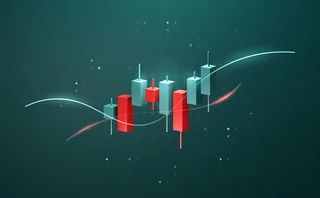Radianz: From a Start-Up to Commercial Viability
ON THE RECORD
CEO Howard Edelstein marks his one-year anniversary with an exclusive interview with Inside Market Data
IMD: Where do you see the greatest growth within Radianz this year?
Edelstein: Geographically, it has been in the US. It’s primarily driven by liquidity. People are trying to find quicker execution venues; hedge fund and buy-side program trading is driving that. People are going for speed, which is where we’ve been. We’re trying to figure out how to leverage that in Europe.
IMD: Where do you see the greatest growth among your client base?
Edelstein: The traditional telco adds clients all the time. Our model is geared toward selling additional services. We already have the infrastructure in place [at a client], so adding another service is a lot more straightforward. At the end of last year, every one-and-one-half-to-two sales out of 10 were to the existing community. It’s closer to 7.8 now.
When you have critical mass, the community starts leveraging the rest of the community. You can buy a whole bunch of stuff or buy an infrastructure.
IMD: How much growth are you seeing from hedge funds?
Edelstein: That’s been absolutely great. For a new or growing hedge fund not to be on Radianz is silly. In the past, you had to install on the hedge fund’s site. Now, we’re doing integration at the
broker for a single access pipe [of the broker’s services]. There’s a lot of back-office integration going on and we’re delighted to deliver that.
There are similar things on the program trading side. We’re getting to the point where 10 milliseconds of speed is an advantage to get that trade. They’re pushing the technology of what you can do. In a proprietary network, you won’t achieve those speeds.
You keep building faster and faster stuff in. A lot is how you implement it. We’re constantly tweaking the topography of the network.
Market data vendors generally have a lot of application engineers but can’t afford a lot of network engineers. At Radianz, we have a lot of network engineers, but their cost is shared among all our customers, which is a much more effective model for the industry.
IMD: You recently appointed Robert Garzilli to the new post of managing director, Americas. Why create this position? Is the Americas a major source of growth for you?
Edelstein: When I first got here, I was trying to figure out what the organization needed to look like. I want to push accountability and decision-making as close to the client as possible. We needed the proper P&L focus on regions and product areas. We will do the same in Europe. Bob comes from a whole different marketplace and will build our experience in FX and fixed income.
IMD: In other recent news, Radianz has sold Radianz Voice Services to WestCom Corp. What does this say about your priorities?
Edelstein: It’s along the lines of reorganizing the management team. Where is our biggest opportunity? There’s a natural synergy that you would expect between voice and data that’s not there yet. There’s a long list of client requests in our core area—extranet and building community. The voice industry has a lot of players and we were never going to make the investment to be number one. WestCom is a great company and we might do something together.
The focus we have now is growing or investing in things adjunct to building the Radianz platform. Over the next year, we will partner or acquire in that area.
IMD: A source tells us that Reuters is looking to reduce or sell its stake in Radianz. What is your response to that and how would you describe your relationship with Reuters?
Edelstein: Reuters has always said that it will step back when Radianz was rock solid. As a platform, that was declared a year and a half ago to be a go. Being viable commercially is where we are now.
Reuters casts a big shadow. We would not be shocked to see [Reuters reduce or sell its stake]. But there is nothing right in front of me.
IMD: At our April Inside Market Data 2004 conference, only two of the major market data vendors said that they offer their full range of services through Radianz. Is this a concern, and if so, how are you responding?
Edelstein: It’s less to do with desire but is as clients demand them. They are all there [in some capacity] except for Interactive Data Corp. The client can ask for anything. We go to the supplier and they typically say, ‘Sure.’ We also go to organizations and say ‘Lots of clients are asking, will you put your services on?’
There are different degrees of strategic [importance]. We would love everyone to be strategic.
Reuters is a hurdle. Some are intimidated by Reuters—[‘If I sign up, am I really supporting Reuters or on the Reuters network?’] We operate quite independently from Reuters. It works against Reuters’ interest to meddle because the value of its stake will go down.
We’re a young company—not everyone has drunk the Kool-Aid yet. But some big customers have and are working with us on new services. We typically try to deliver what these clients want us to (because they are leaders in industry).
IMD: What is the biggest hurdle?
Edelstein: The perception of Reuters is a big hurdle. The other hurdle is a lack of understanding by most large organizations that they don’t have to invest their own capital like they did a few years ago. We’ve shown through total cost of ownership calculations or client case studies that anyone who converted from fixed cost to variable cost [did well].
It’s a different methodology [from telcos]. We can do what their proprietary networks can’t do. Customers pay for what they use and we give them connectivity to the client they want. They can’t go to a network provider to do this. Previously, you bought bandwidth, which is very expensive. Everyone had point-to-point spaghetti. With the cloud model, we’re amortizing the cost of the network. We figured out how to share not just the core but the last mile to the client by service access. We pass along the savings.
The model is great; we initially sold on a cost recovery basis. Now we’re getting more profitable because we can get more clients on sharing the same infrastructure.
IMD: How have concerns about disaster recovery changed since 2001 and how has that affected Radianz?
Edelstein: It’s built into the DNA of what we do. We have 20 guys in security. Six to eight worry specifically about resilience. Just because you buy from two different vendors doesn’t mean you have resilience. A typical organization with do it yourselfs, they take their best shot but you’re not really sure.
[With Radianz,] everyone benefits but you pay for the pro rata share. It’s why the blackouts didn’t have an effect on clients; clients went dark, but they didn’t have to.
IMD: What effects have you seen from the growth of market data volumes?
Edelstein: It increases business. It’s a little problematic for the individual. I’m not sure there’s enough revenue for the costs to deal with all that market data. Some clients cache locally. We offer hosting, hosting and POPs—facilities to co-locate streaming data from one location. We sell hosted as part of the managed service. As we partner with more strategy-level partners, with a large market data vendor, let’s talk how we can optimize your architecture.
It’s the hot button of what people are asking for. But it’s talked about less and less.
Clients are surprised. They’re suddenly bursting their pipe seams. They’re not measuring as closely as they should be. If it’s managed, they don’t have anything to worry about, but a proprietary network means buying and buying. You can offload it to someone who does that for a living.
IMD: How does the advent of direct exchange links affect you, if at all?
Edelstein: We carry many more direct exchanges to many more clients.
Nobody wants to spend the time to go through the ticker plant. Some think we’re competing with the consolidated feeds. They are two different markets. There’s a fast growing market for direct data, but it’s limited because it’s geared around trading. People are having to take multiple sets of feeds.
Clients are buying and using it for trading purposes to get a little edge. Everyone is looking to steal share from the next guy. It’s down to pennies; you’ve got to be as fast as hell.
IMD: Next week is your one-year anniversary at Radianz. What do you consider to be your greatest accomplishment and what do you still have to accomplish?
Edelstein: Until 2003 Radianz wasn’t really commercial, though it built out a world-class infrastructure. We’ve spent a lot of energy on billing systems… [to create a] self-sustaining, profitable business. We’re a big start-up—we have a reliable network but as a business, we’re a start-up.
2004 is a transition year of getting those things bedded down. In 2005, we will kick ass and take names and really grow. I’m glad we’re not a public company, because we wouldn’t have the chance to build what you need to build. It’s fortunate that we were able to spend 2004 bedding down to support the operation.
Before joining Radianz, I spent the last two years at Warburg Pincus. Radianz has the potential to be an independent platform—it is such a tremendous opportunity. If you had to duplicate this business today, I don’t know how you would do it.
My goal is to be a neutral platform for the industry.
| CEO Confidential |
| Name: P. Howard Edelstein Hometown: Bronx, New York Education: City College NY; Stanford University Homes: New York and Boston Family: Two of the world’s greatest kids and a fabulous ex-wife What book are you reading now? Never less than than three at a time: Against all Enemies by Richard Clark; HyperSpace by Michio Kaku; House of Bush, House of Saud by Craig Unger; Relax It’s Only Uncertainty by White & Hodgson; and a “junk book” by Clancy Style. What CD is in your stereo? John Mayer—Groom for Squares; The Who—Tommy; Billy Joel; Bob Dylan —Blood on the Tracks; and “oldies”. What’s the last movie you watched? Cold Mountain and The Day After Tomorrow. What is your favorite sport to watch? Baseball and tennis. Which team do you root for? New York Yankees (especially when they play the Red Sox). What’s your favorite city to visit? Prague, it’s so amazing. What was your first paying job? Working in the local deli. I was 14 years old…it was a great job—you got all the pickles you could eat! Who was your mentor and what did they teach you? She was wise beyond her years—to be good at what you do does not mean having to be right, and “listening” does not mean preparing to answer. If you could have dinner with any person, who would it be and why? Albert Einstein—I’m still trying to figure out this speed of light thing and why it doesn’t work on the FDR drive. How much sleep do you get each night? About five hours, but I catch up by taking naps in taxis. |
Only users who have a paid subscription or are part of a corporate subscription are able to print or copy content.
To access these options, along with all other subscription benefits, please contact info@waterstechnology.com or view our subscription options here: http://subscriptions.waterstechnology.com/subscribe
You are currently unable to print this content. Please contact info@waterstechnology.com to find out more.
You are currently unable to copy this content. Please contact info@waterstechnology.com to find out more.
Copyright Infopro Digital Limited. All rights reserved.
As outlined in our terms and conditions, https://www.infopro-digital.com/terms-and-conditions/subscriptions/ (point 2.4), printing is limited to a single copy.
If you would like to purchase additional rights please email info@waterstechnology.com
Copyright Infopro Digital Limited. All rights reserved.
You may share this content using our article tools. As outlined in our terms and conditions, https://www.infopro-digital.com/terms-and-conditions/subscriptions/ (clause 2.4), an Authorised User may only make one copy of the materials for their own personal use. You must also comply with the restrictions in clause 2.5.
If you would like to purchase additional rights please email info@waterstechnology.com
More on Trading Tech
After acquisitions, Exegy looks to consolidated offering for further gains
With Vela Trading Systems and Enyx now settled under one roof, the vendor’s strategy is to be a provider across the full trade lifecycle and flex its muscles in the world of FPGAs.
Enough with the ‘Bloomberg Killers’ already
Waters Wrap: Anthony interviews LSEG’s Dean Berry about the Workspace platform, and provides his own thoughts on how that platform and the Terminal have been portrayed over the last few months.
BofA deploys equities tech stack for e-FX
The bank is trying to get ahead of the pack with its new algo and e-FX offerings.
Pre- and post-trade TCA—why does it matter?
How CP+ powers TCA to deliver real-time insights and improve trade performance in complex markets.
Driving effective transaction cost analysis
How institutional investors can optimize their execution strategies through TCA, and the key role accurate benchmarks play in driving more effective TCA.
As NYSE moves toward overnight trading, can one ATS keep its lead?
An innovative approach to market data has helped Blue Ocean ATS become a back-end success story. But now it must contend with industry giants angling to take a piece of its pie.
BlackRock, BNY see T+1 success in industry collaboration, old frameworks
Industry testing and lessons from the last settlement change from T+3 to T+2 were some of the components that made the May transition run smoothly.
Banks seemingly build more than buy, but why?
Waters Wrap: A new report states that banks are increasingly enticed by the idea of building systems in-house, versus being locked into a long-term vendor contract. Anthony explores the reason for this shift.







